Activities of the American
Red Cross
Military and Naval Welfare Service
(Services to the Armed Forces
and Veterans)
.
The military-oriented services of the Red
Cross was coordinated by field directors who were stationed at stateside
Army and Navy stations and hospitals as well as stationed with troops and
hospitalized service personnel overseas.
They worked in cooperation with the Red Cross
chapters throughout the United States and its possessions. This way they
linked the servicemen and women with their home communities in a constant
two-way flow of service. |
.. |
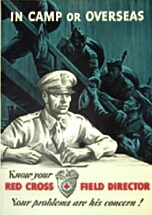 |
.
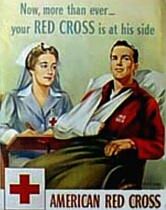 |
v |
The American Red Cross contributed to the
morale of servicemen and women by a program of social service including
financial assistance for service personnel and their families, and by a
program of medical social service and recreation for the sick and injured
in Army and Navy hospitals.
Field directors in Veterans Administration
offices and chapter workers assisted veterans and their families in obtaining
benefits from the Government. Chapters provide financial assistance pending
the receipt of governmental benefits. |
.
| Most large army camps and many other military
reservations had Red Cross buildings. Both the Army and Navy allocated
space in hospitals for the use of the Red Cross staff in carrying out activities
for patients, and furnishings for these quarters were supplied by the Red
Cross.
Red Cross hospital workers provided social
service and medically approved recreation programs for patients in evacuation
hospitals, in general hospitals, and on hospital ships. |
.. |
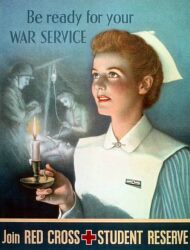 |
.
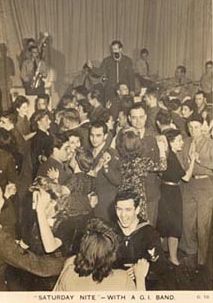 American Red Cross Service
Club
American Red Cross Service
Club
|
.v |
Club facilities that provided food, lodging,
and entertainment were established in metropolitan and leave areas in all
overseas war theaters.
.
v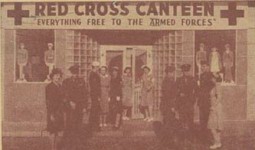 .
Aero-clubs, clubmobiles, and on-post service clubs
were also staffed and operated by the Red Cross according to indicated
need and request for such service by the military authorities.
.
Aero-clubs, clubmobiles, and on-post service clubs
were also staffed and operated by the Red Cross according to indicated
need and request for such service by the military authorities. |
.
|
The following are the Services
that worked as part of the Military and Naval Welfare Service:
- Camp and Hospital Council Service
- Camp Service
- Club Service
- Home Service
- Hospital Service
- Nursing Service
- Service in Veterans Hospitals (SVH) |
.v |
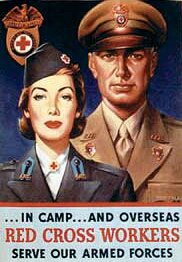 |
.
Camp and Hospital Council
Service
.
| Service: |
. |
Throughout World War II |
| Strength: |
|
181 councils with paid field directors, supported
by 2,204 chapters with local volunteers (1945) |
| Duty: |
|
Provided emergency services, supplemental
services (such as art exhibits and hospital parties) and delivered extra
supplies ranging from books to musical instruments, to 4,096 military stations
and hospitals within the United States. |
|
|
Camp Service
.
| Service: |
. |
Throughout World War II |
| Strength: |
|
3,520 paid field directors and assistant field
directors (1945) |
| Duty: |
|
Served both overseas and in stateside military
locations to provide counseling and guidance for service personnel having
either military or personal problems, facilitated communication with families
and hometowns, rendered financial assistance and distributed requested
supplies. |
|
|
Club
Service
.
| Service: |
. |
Throughout World War II |
| Strength: |
|
5,000 paid workers and 140,000 volunteers
(1945) |
| Duty: |
|
Operated large service clubs (such as the
famous Rainbow Corner Club in London) and small service clubs (such as
Doughnut Dugouts for troops, Fleet Clubs for sailors and Aeroclubs for
airmen); operated clubmobiles and cinemobiles (clubmobiles converted into
mobile movie theaters) in forward or isolated combat areas; staffed and
supplied 2,000 recreational facilities overseas, and maintained presence
in staff homes and stateside hospitals.
More information about the Red
Cross Clubmobile Service
here |
|
|
Home Service
.
| Service: |
. |
Throughout World War II |
| Strength: |
|
3,757 local chapters with local volunteers
(1941-45) |
| Duty: |
|
Maintained close contact with the Camp and
Hospital Service field directors to remedy problems of service members,
gave consultation; facilitated communications between service members and
families, and provided financial assistance based on need. |
|
|
Hospital Service
.
| Service: |
. |
Throughout World War II |
| Strength: |
|
Unspecified (1945) |
| Duty: |
|
Provided social, medical and psychiatric services
for military patients in overseas and stateside hospitals by paid Red Cross
social workers and professional and specially trained personnel, supplemented
by recreational programs provided by unpaid volunteers. |
|
|
Nursing Service
.
| Service: |
. |
Throughout World War II |
| Strength: |
|
212,000, including 71,000 who joined the military
(1941-45) |
| Duty: |
|
Recruited and enrolled nurses, and certified
those qualified for military service for duty with the armed forces. |
|
|
Service in Veterans Hospitals
(SVH)
.
| Service: |
. |
Established August 1945 |
| Strength: |
|
Unspecified |
| Duty: |
|
Provided service to hospitalized veterans
in Veterans Administration hospitals within the United States by using
both paid professional staff, Gray Ladies and Nurse's Aides. |
|
.
Insular and Foreign Operations
.
Insular and foreign operations of the American
Red Cross included activities in the nine chapters in insular possession's
services to the American military forces outside the continental limits
of the United States, relief to prisoners of war, foreign disaster and
war relief operations, and relationships with the foreign Red Cross societies
and with the two international Red Cross organizations (the International
Red Cross Committee and the League of Red Cross Societies).
.
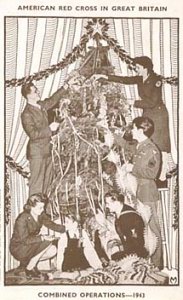 |
.. |
The American Red Cross, at the request of
the Army and Navy, provided recreation and welfare facilities for US armed
forces in foreign countries and islands.
There were Red Cross medical social workers
and recreation workers in the overseas hospitals. Other workers were stationed
inside the camps and with the troops, wherever they served. |
.
Relief to Prisoners of War: The
American Red Cross endeavored to provide regular shipments of food parcels,
toilet and comfort articles, clothing, and medical supplies for distribution
to men to captured Americans, whether held as prisoners of war or held
as civilian internees. The International Red Cross Committee maintained
a central agency for prisoners of war at Geneva.
.
Civilian Relief: The
foreign relief of the American Red Cross made necessary by World War II
was undertaken in over 41 different countries. This work was carried on
in close cooperation with the United States Government and the Red Cross
society of each country that received aid. |
.. |
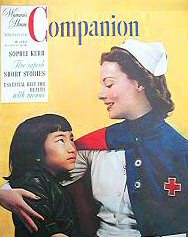 |
|
